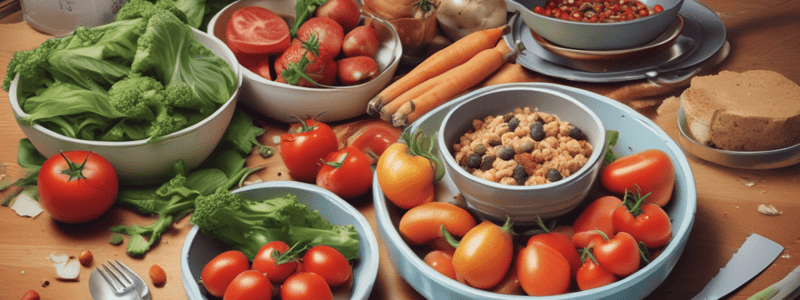Podcast
Questions and Answers
Washing hands frequently is important, especially before and after handling food.
Washing hands frequently is important, especially before and after handling food.
True (A)
Perishable foods should be stored at temperatures below 40 degrees Fahrenheit.
Perishable foods should be stored at temperatures below 40 degrees Fahrenheit.
True (A)
Cross-contamination can be prevented by keeping hazardous and non-hazardous foods together.
Cross-contamination can be prevented by keeping hazardous and non-hazardous foods together.
False (B)
Thawing foods in the refrigerator or microwave is recommended to prevent foodborne illness.
Thawing foods in the refrigerator or microwave is recommended to prevent foodborne illness.
Washing meat is a good practice to prevent bacteria spreading.
Washing meat is a good practice to prevent bacteria spreading.
Dishes and utensils should be washed with hot, soapy water at least 140 F.
Dishes and utensils should be washed with hot, soapy water at least 140 F.
If food smells, tastes, or looks bad, it is safe to use as long as you cook it well.
If food smells, tastes, or looks bad, it is safe to use as long as you cook it well.
Refrigerating food helps in preventing foodborne illness.
Refrigerating food helps in preventing foodborne illness.
Fruits and vegetables that will be eaten raw should be washed properly.
Fruits and vegetables that will be eaten raw should be washed properly.
Throw out sponges if they are smelly or look dirty.
Throw out sponges if they are smelly or look dirty.
Flashcards are hidden until you start studying
Study Notes
Choosing and Preparing Nutritious Foods
Influences on Food Choices
- Genetics: preferences for different types of foods (e.g., salty, fatty)
- Age: food preferences change as people get older
- Feelings and emotions: comfort foods release neurotransmitters that lead to feelings of happiness
- Cultural background: unique foods and traditions in different cultures (e.g., guinea pig in Peru, rice and peas in Jamaica)
- Flavor: preferences for certain flavors (e.g., salty, spicy, bland)
Analyzing Influences on Food Choices
- Food preferences: opinions about specific foods and cuisines
- Research shows that genes play a limited role in food preferences
- Identical twins raised in the same household may have vastly different food likes and dislikes
- Food preferences change as people get older
- Feelings and thoughts: people experiencing uncomfortable emotions tend to crave comfort foods
- Physiology and body type: people with different body types and metabolisms may crave different foods
- Culture and society: people from different cultures have different food preferences
Strategies for Eating Healthy in Social Situations
- Eat before the event to prevent hunger
- Bring a healthy dish to share
- Suggest eating healthy snacks or foods
- Use specific excuses to refuse food (e.g., "I'm not hungry", "I can't eat that food")
- Acknowledge someone's food with a compliment (e.g., "This is incredible but I couldn't eat another bite")
Understanding Nutrition Facts and Food Labels
- Nutrition Facts Label: provides consumers with a consistent format for comparing nutrient content
- Includes serving size, calories, nutrients, and percent Daily Value
- Ingredients list: orders ingredients by weight, allows consumers to avoid certain ingredients (e.g., allergens, GMOs)
Daily Values (DV)
- Recommended daily intake of nutrients for a 2,000-calorie diet
- Used to calculate percent Daily Value of nutrients in a food
- Based on assumptions of average person's needs (e.g., 2,000 calories, moderately active)
- May need to adjust DV based on individual needs
Ingredients in Foods
- List of ingredients in order of weight
- Added sugars: different names for sugar (e.g., fructose, dextrose, honey)
- Food additives: extend shelf life, improve flavor, or cause other changes
- Generally Recognized as Safe (GRAS): list of safe food additives
Assessing Claims on Food Labels
- Low-fat: must contain no more than 3 grams of fat per serving
- Organic: must consist of at least 95% organically produced ingredients
- GMOs: foods produced using genetic modification
- Heart-healthy foods: must contain at least 51% whole-grain ingredients and be low in fat, saturated fat, and cholesterol
Preparing Nutritious Food
-
Benefits of preparing own food: cheaper, control over ingredients, limit added substances
-
Make-ahead healthy snacks: fruit and yogurt parfait, hummus and vegetables, smoothie
-
Foodborne illnesses: caused by disease-causing microorganisms, preventable through proper handling and preparation### Practice Health-Enhancing Behaviors
-
Choose a favorite meal or snack and find a recipe to prepare it
-
Follow the recipe using these steps:
- Review the list of ingredients and measurements
- Assess the nutritional value and number of servings
- Read the directions before starting
- Determine the preparation time and gather supplies
- Wash fruits and vegetables before use
- Prepare the food, avoiding cross-contamination and recording the process
- Share the cooking video and experience with the class
Preventing Foodborne Illness
- Wash hands, linens, and surfaces with soap and water
- Prevent cross-contamination by separating hazardous and non-hazardous foods
- Refrigerate food at 40°F or below and cook to proper temperatures
- Wash fruits and vegetables that will be eaten raw
- Avoid washing meat, as it can spread bacteria
- Thaw foods safely and wash dishes with hot, soapy water
Review
- Store food at proper temperatures and illumination to maintain quality
- Factors affecting food longevity include storage, handling, and quality
- Nutrition Information on products includes nutrients and calories
- Compare organic and conventional food storage methods
- Preparing food influences daily health through nutrient choices and cooking methods
- Research food additives and their effects
- Brainstorm and prepare healthy snacks for school
- Create a tutorial video on a food safety strategy
Studying That Suits You
Use AI to generate personalized quizzes and flashcards to suit your learning preferences.




